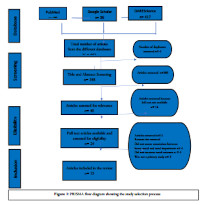Heavy Metal Exposure and Renal Impairment: A Systematic Review of Observational Studies
DOI:
https://doi.org/10.60787/tnhj.v23i3.713Keywords:
observational study, renal impairment, kidney disease, heavy metal exposureAbstract
Background: Environmental exposure to toxins has been strongly implicated in its multi-faceted etiology of chronic kidney disease, a serious public health problem affecting individuals, families, and communities. There is a need to synthesize available studies on the effect of heavy metal exposure on renal function, considering the rising global burden of kidney disease. The objective of this study is to determine the association between exposure to heavy metals and renal disease.
Methods: The Preferred Reporting Items for Systematic Review and Meta-Analysis (PRISMA) were used to conduct the review. A
comprehensive independent search, title, abstract, and full-text screening of available literature on Google Scholar, PubMed, and
OAREScience was done between March 2021 and May 2021. The criteria for study inclusion were full-text articles published in English
language in the last 20 years (2001-2020), and observational primary human studies reporting the association between heavy metal exposure and renal disease. The Newcastle-Ottawa Quality Assessment Scale was used to assess the quality of the included studies.
Results: A total of 552 studies were identified following the search from the different databases. A total of 13 studies were finally included in the review. Heavy metals implicated in the studies include cadmium, lead, mercury, and arsenic, with ten studies showing environmental exposure as the primary source. Ten (10) studies showed an association between heavy metal exposure and renal impairment (p<0.05) while only 3 studies reported no association.
Conclusion: Environmental monitoring is needed to stem the tide of heavy metal exposure in view of the growing burden of chronic kidney disease.
Downloads
References
Luyckx VA, Tonelli M, Stanifer JW %J B of the WHO. The global burden of kidney disease and the sustainable development goals. 2018;96(6):414.
Levin A, Tonelli M, Bonventre J, Coresh J, Donner JA, Fogo AB, et al. Global kidney health 2017 and beyond: a roadmap for closing gaps in care, research, and policy. Lancet. 2017;390(10105):1888–917.
Feng X, Hou N, Chen Z, Liu J, Li X, Sun X, et al. Secular trends of epidemiologic patterns of chronic kidney disease over three decades: an updated analysis of the Global Burden of Disease Study 2019. BMJ Open. 2023 Mar;13(3):e064540.
Stanifer JW, Muiru A, Jafar TH, Patel UD %J NDT. Chronic kidney disease in low-and middle-income countries. 2016;31(6):868–74.
Kovesdy CP. Epidemiology of chronic kidney disease: an update 2022. Kidney Int Suppl. 2022;12(1):7–11.
Jha V, Garcia-Garcia G, Iseki K, Li Z, Naicker S, Plattner B, et al. Chronic kidney disease: global dimension and perspectives. 2013;382(9888):260–72.
Liyanage T, Ninomiya T, Jha V, Neal B, Patrice HM, Okpechi I, et al. Worldwide access to treatment for end-stage kidney disease: a systematic review. Lancet. 2015;385(9981):1975–82.
Mehta RL, Cerdá J, Burdmann EA, Tonelli M, GarcíaGarcía G, Jha V, et al. International Society of Nephrology’s 0by25 initiative for acute kidney injury (zero preventable deaths by 2025): a human rights case for nephrology. Lancet. 2015;385(9987):2616–43.
Bello AK, Levin A, Tonelli M, Okpechi IG, Feehally J, Harris D et al. Global Kidney Health Atlas. Brussels: . Int Soc Nephrol. 2017;
Lunyera J, Mohottige D, Von Isenburg M, Jeuland M, Patel UD, Stanifer JW %J CJ of the AS of N. CKD of uncertain etiology: a systematic review. 2016;11(3):379–85.
Elliott EG, Ma X, Leaderer BP, McKay LA, Pedersen CJ, Wang C, et al. A community-based evaluation of proximity to unconventional oil and gas wells, drinking water contaminants, and health symptoms in Ohio. Environ Res. 2018 Nov;167:550–7.
Hu H. Human health and heavy metals exposure. Life Support Environ Hum Heal MIT Press Cambridge. 2002;65–82.
UNEP. Environmental Assessment of Ogoniland Site Specific Fact Sheets. 2011. 1–257 p.
Akporido SO, Onianwa PC. Heavy metals and total petroleum hydrocarbon concentrations in surface water of Esi River, Western Niger Delta. Res J Environ Sci. 2015;9(2):88.
Nriagu J. Oil industry and the health of communities in the Niger Delta of Nigeria. 2011;
Steiner R. Double standard: Shell practices in Nigeria compared with international standards to prevent and control pipeline oil spills and the Deepwater Horizon oil spill. Milieudefensie, Amsterdam. 2010;11–5.
Kadafa AA. Environmental impacts of oil exploration and exploitation in the Niger Delta of Nigeria. Glob J Sci Front Res Environ Earth Sci. 2012;12(3):19–28.
Kadafa AA. Oil exploration and spillage in the Niger Delta of Nigeria. Civ Environ Res. 2012;2(3):38–51.
Anyanwu BO, Ezejiofor AN, Igweze ZN, Orisakwe OE. Heavy metal mixture exposure and effects in developing nations: an update. Toxics. 2018;6(4):65.
Kim NH, Hyun YY, Lee KB, Chang Y, Rhu S, Oh KH, et al. Environmental heavy metal exposure and chronic kidney disease in the general population. J Korean Med Sci. 2015;30(3):272–7.
Earthworks. Tailings. 2019; Available from: www.earthworks.org/issues/tailings/ on 2, July 2021
Jaishankar M, Tseten T, Anbalagan N, Mathew BB, Beeregowda KN. Toxicity, mechanism and health effects of some heavy metals. Interdiscip Toxicol. 2014;7(2):60–72.
Lambert M, Leven BA, Green RM. New methods of cleaning up heavy metal in soils and water. Environ Sci Technol briefs citizens. 2000;1–3.
Engwa GA, Ferdinand PU, Nwalo FN, Unachukwu MN. Mechanism and health effects of heavy metal toxicity in humans. Poisoning Mod world-new tricks an old dog. 2019;10.
World Health Organization. Exposure to Lead: A major public health concern. World Heal Organ. 2010;6.
Page MJ, McKenzie JE, Bossuyt PM, Boutron I, Hoffmann TC, Mulrow CD, et al. The PRISMA 2020 statement: an updated guideline for reporting systematic reviews. Bmj. 2021;372.
Modesti, P. A., Reboldi, G., & Cappuccio FP (2016). Newcastle-Ottawa Quality Assessment Scale (adapted for cross sectional studies). PLoS One.le. 2016;
Hambach R, Lison D, D’haese PC, Weyler J, De Graef E, De Schryver A, et al. Co-exposure to lead increases the renal response to low levels of cadmium in metallurgy workers. Toxicol Lett. 2013;222(2):233–8.
Suwazono Y, Nogawa K, Uetani M, Miura K, Sakata K, Okayama A, et al. Application of hybrid approach for estimating the benchmark dose of urinary cadmium for adverse renal effects in the general population of Japan. J Appl Toxicol. 2011;31(1):89– 93.
Jayatilake N, Mendis S, Maheepala P, Mehta FR, National C. Chronic kidney disease of uncertain aetiology: prevalence and causative factors in a developing country. BMC Nephrol. 2013;14(1):1–13.
Uno T, Kobayashi E, Suwazono Y, Okubo Y, Miura K, Sakata K, et al. Health effects of cadmium exposure in the general environment in Japan with special reference to the lower limit of the benchmark dose as the threshold level of urinary cadmium. Scand J Work Environ Health. 2005;31(4):307–15.
Samir AM, Aref WM. Impact of occupational exposure to elemental mercury on some antioxidative enzymes among dental staff. Toxicol Ind Health. 2011;27(9):779–86.
Rango T, Jeuland M, Manthrithilake H, McCornick P. Nephrotoxic contaminants in drinking water and urine, and chronic kidney disease in rural Sri Lanka. Sci Total Environ. 2015;518:574–85.
Karmaus W, Dimitrov P, Simeonov V, Tsolova S, Bonev A, Georgieva R. Metals and kidney markers in adult offspring of endemic nephropathy patients and controls: a two-year follow-up study. Environ Heal. 2008;7(1):1–11.
Hsueh YMM, Chung CJJ, Shiue HSS, Chen JBB, Chiang SSS, Yang MHH, et al. Urinary arsenic species and CKD in a Taiwanese population: a case-control study. Am J Kidney Dis [Internet]. 2009;54(5):859–70. Available from: http://dx.doi.org/10.1053/j.ajkd.2009.06.016
Cadmium B, Hwangbo Y, Weaver VM, Tellez-Plaza M, Guallar E, Lee BK, et al. Blood cadmium and estimated glomerular filtration rate in Korean adults. Environ Health Perspect. 2011;119(12):1800–5.
Thomas LDK, Hodgson S, Nieuwenhuijsen M, Jarup L. Early kidney damage in a population exposed to cadmium and other heavy metals. Environ Health Perspect. 2009;117(2):181–4.
Noonan CW, Sarasua SM, Campagna D, Kathman SJ, Lybarger JA, Mueller PW. Effects of exposure to low levels of environmental cadmium on renal biomarkers. Environ Health Perspect. 2002;110(2):151–5.
Ke S, Cheng X yu, Zhang JY, Jia WJ, Li H, Luo H fang, et al. Estimation of the benchmark dose of urinary cadmium as the reference level for renal dysfunction: a large sample study in five cadmium polluted areas in China. BMC Public Health. 2015;15(1):1–10.
Kassebaum NJ, Arora M, Barber RM, Bhutta ZA, Brown J, Carter A et al. . GBD 2015 DALYs and HALE Collaborators. Global, regional, and national disability-adjusted life-years (DALYs) for 315 diseases and injuries and healthy life expectancy (HALE), 1990-2015: a systematic analysis for the Global Burden of Disease Study 2015. Lancet. 2016;10 8(;388(10053):):1603– 58.
Levey AS, Eckardt KU, Tsukamoto Y, Levin A, Coresh J, Rossert J, et al. Definition and classification of chronic kidney disease: a position statement from Kidney Disease: Improving Global Outcomes (KDIGO). Kidney Int. 2005;67(6):2089–100.
Levin A, Stevens PE, Bilous RW, Coresh J, De Francisco ALM, De Jong PE, et al. Kidney Disease: Improving Global Outcomes (KDIGO) CKD Work Group. KDIGO 2012 clinical practice guideline for the evaluation and management of chronic kidney disease. Kidney Int Suppl. 2013;3(1):1–150.
United States D of H and HS. TOXICOLOGICAL PROFILE FOR CADMIUM. 2012;(September).
Mueller PW, Dallas Hall W, Caudill SP, MacNeil ML, Arepally A. An in-depth examination of the excretion of albumin and other sensitive markers of renal damage in mild hypertension. Am J Hypertens. 1995;8(11):1072–82.
Mueller PW, Price RG, Finn WF. New approaches for detecting thresholds of human nephrotoxicity using cadmium as an example. Environ Health Perspect. 1998;106(5):227–30.
Lauwerys RR, Bernard AM, Roels HA, Buchet JP. Cadmium: exposure markers as predictors of nephrotoxic effects. Clin Chem. 1994;40(7):1391–4.
Mueller PW, Paschal DC, Hammel RR, Klincewicz SL, MacNeil ML, Spierto B, et al. Chronic renal effects in three studies of men and women occupationally exposed to cadmium. Arch Environ Contam Toxicol. 1992;23(1):125–36.
Struthers SA, Kribs Z, Butler CR. Policy and Kidney Community Engagement to Advance toward Greener Kidney Care. J Am Soc Nephrol. 2022;33(10):1811–3.
Orisakwe OE %J NA journal of medical sciences. Lead and cadmium in public health in Nigeria: physicians neglect and pitfall in patient management. 2014;6(2):61.
Fasinu PS, Orisakwe OE %J APJ of CP. Heavy metal pollution in sub-Saharan Africa and possible implications in cancer epidemiology.
;14(6):3393–402.

Published
How to Cite
Issue
Section
License
Copyright (c) 2023 Journal and Publisher

This work is licensed under a Creative Commons Attribution-NonCommercial-NoDerivatives 4.0 International License.
The Journal is owned, published and copyrighted by the Nigerian Medical Association, River state Branch. The copyright of papers published are vested in the journal and the publisher. In line with our open access policy and the Creative Commons Attribution License policy authors are allowed to share their work with an acknowledgement of the work's authorship and initial publication in this journal.
This is an open access journal which means that all content is freely available without charge to the user or his/her institution. Users are allowed to read, download, copy, distribute, print, search, or link to the full texts of the articles in this journal without asking prior permission from the publisher or the author.
The use of general descriptive names, trade names, trademarks, and so forth in this publication, even if not specifically identified, does not imply that these names are not protected by the relevant laws and regulations. While the advice and information in this journal are believed to be true and accurate on the date of its going to press, neither the authors, the editors, nor the publisher can accept any legal responsibility for any errors or omissions that may be made. The publisher makes no warranty, express or implied, with respect to the material contained herein.
TNHJ also supports open access archiving of articles published in the journal after three months of publication. Authors are permitted and encouraged to post their work online (e.g, in institutional repositories or on their website) within the stated period, as it can lead to productive exchanges, as well as earlier and greater citation of published work (See The Effect of Open Access). All requests for permission for open access archiving outside this period should be sent to the editor via email to editor@tnhjph.com.









